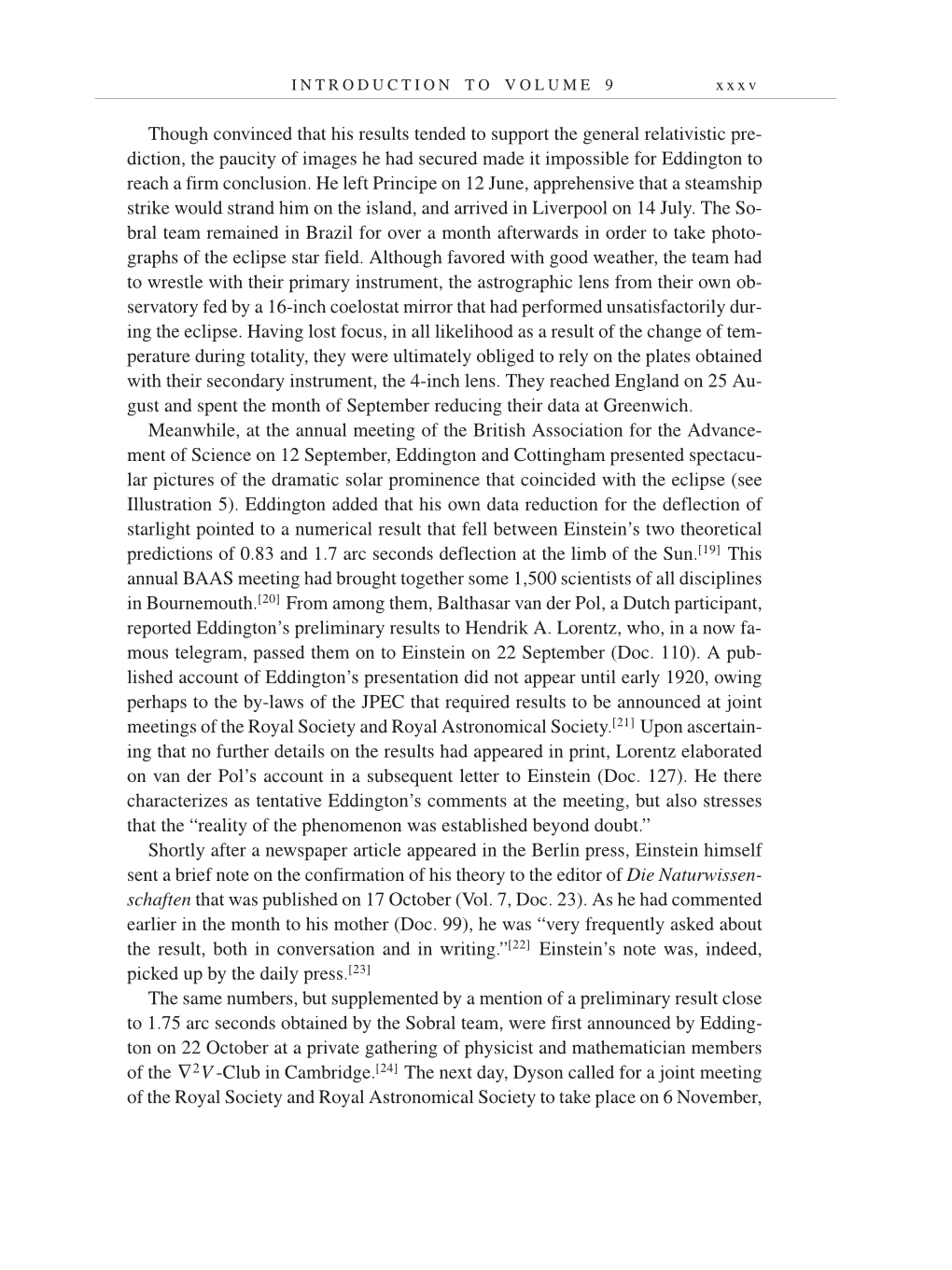I N T R O D U C T I O N T O V O L U M E 9 x x x v
Though convinced that his results tended to support the general relativistic pre-
diction, the paucity of images he had secured made it impossible for Eddington to
reach a firm conclusion. He left Principe on 12 June, apprehensive that a steamship
strike would strand him on the island, and arrived in Liverpool on 14 July. The So-
bral team remained in Brazil for over a month afterwards in order to take photo-
graphs of the eclipse star field. Although favored with good weather, the team had
to wrestle with their primary instrument, the astrographic lens from their own ob-
servatory fed by a 16-inch coelostat mirror that had performed unsatisfactorily dur-
ing the eclipse. Having lost focus, in all likelihood as a result of the change of tem-
perature during totality, they were ultimately obliged to rely on the plates obtained
with their secondary instrument, the 4-inch lens. They reached England on 25 Au-
gust and spent the month of September reducing their data at Greenwich.
Meanwhile, at the annual meeting of the British Association for the Advance-
ment of Science on 12 September, Eddington and Cottingham presented spectacu-
lar pictures of the dramatic solar prominence that coincided with the eclipse (see
Illustration 5). Eddington added that his own data reduction for the deflection of
starlight pointed to a numerical result that fell between Einstein’s two theoretical
predictions of 0.83 and 1.7 arc seconds deflection at the limb of the
Sun.[19]
This
annual BAAS meeting had brought together some 1,500 scientists of all disciplines
in
Bournemouth.[20]
From among them, Balthasar van der Pol, a Dutch participant,
reported Eddington’s preliminary results to Hendrik A. Lorentz, who, in a now fa-
mous telegram, passed them on to Einstein on 22 September (Doc. 110). A pub-
lished account of Eddington’s presentation did not appear until early 1920, owing
perhaps to the by-laws of the JPEC that required results to be announced at joint
meetings of the Royal Society and Royal Astronomical
Society.[21]
Upon ascertain-
ing that no further details on the results had appeared in print, Lorentz elaborated
on van der Pol’s account in a subsequent letter to Einstein (Doc. 127). He there
characterizes as tentative Eddington’s comments at the meeting, but also stresses
that the “reality of the phenomenon was established beyond doubt.”
Shortly after a newspaper article appeared in the Berlin press, Einstein himself
sent a brief note on the confirmation of his theory to the editor of Die Naturwissen-
schaften that was published on 17 October (Vol. 7, Doc. 23). As he had commented
earlier in the month to his mother (Doc. 99), he was “very frequently asked about
the result, both in conversation and in
writing.”[22]
Einstein’s note was, indeed,
picked up by the daily
press.[23]
The same numbers, but supplemented by a mention of a preliminary result close
to 1.75 arc seconds obtained by the Sobral team, were first announced by Edding-
ton on 22 October at a private gathering of physicist and mathematician members
of the -Club in
Cambridge.[24]
The next day, Dyson called for a joint meeting
of the Royal Society and Royal Astronomical Society to take place on 6 November,
∇2V
